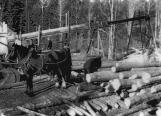14
Logs Waiting Processing, North Shore, Nova Scotia, Canada1900
North Shore, Nova Scotia, Canada
 Credits:
Credits:North Shore Archives CSHC
15
The mill owner would negotiate with the woodlot owners for the sale of cutting rights to standing timber. The size of the area was assessed and the farmer got cash based on the lumber estimate and the market price of the rough timber. Often there was a crew of 10 men for smaller mills, which provided an accommodation camp and house to feed in, and shelter for the horses.Larger mills often employed a large staff, up to 30 men, to carry out the industry's demands. A man sporting an axe and saw could be paid $30-$35 each month plus room and board. A man with a horse or team of horses would be paid additionally.
16
Lumber Piles, North Shore, Nova Scotia, Canada1914
North Shore, Nova Scotia, Canada
 Credits:
Credits:North Shore Archives CSHC
17
Another source of revenue was to obtain the means to haul lumber from the mills to the railway siding. The hauler was paid in accordance with the number of board feet per load, so there was competition to load the largest amount of lumber on each sled or wagon, and to be the first to get to the siding. The industry flourished, with large quantities of timber being exported.Teamsters were fond of their horses or oxen, and a close bond between them increased efficiency. Animals were fed before breakfast, while other men slept, and during the day, blanketing, the clearing of ice from hooves, or seeing to injuries, kept the teamster busy.